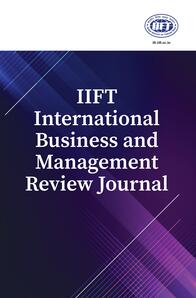
1Institute of Public Enterprise, Shamirpet, Hyderabad, Telangana, India
Creative Commons Non Commercial CC BY-NC: This article is distributed under the terms of the Creative Commons Attribution-NonCommercial 4.0 License (http://www.creativecommons.org/licenses/by-nc/4.0/) which permits non-Commercial use, reproduction and distribution of the work without further permission provided the original work is attributed.
Retailer is the last channel partner of any distribution chain. Retailer plays a very important role in the sale of manufactured goods or service. The customer provides a lot of insights at the retail point on the products and services sold by different manufacturers. These insights are very essential in the development of new products. In the case of large manufacturers, they have different sources of customer insights and product strategies to come out with new innovative products and move up in the market. But for small and medium suppliers/manufacturers, with limited resources and information, it is not easy. In such situations, retailers play a very important role in providing insights to these small and medium suppliers/manufacturers and help them in making alterations to the existing products, developing new products or introducing their existing products in new markets. This brings in the need for exploration and validation of various parameters that define efficiency in modern retail. The modern retailer can always pose challenges to small and medium industries/suppliers in making onerous trade agreements, including credit limit, credit period and sale-or-return, which squarely place the burden of funding the retailer’s business on the small and medium enterprises (SME)/supplier, and so on. Unless there is a mandate of better payment terms, the evolution of modern retail can spell an end to barely alive Indian SMEs. As part of this study, small and medium suppliers/manufacturers were interviewed for various parameters that would have an impact on their innovation capabilities. With the help of analysis, it is proved that there is a significant impact created by these large companies on their innovation capacities. Unless there is a mandate of better payment terms and knowledge sharing system, the evolution of modern retail can spell an end to barely alive Indian SMEs.
Modern retail, suppliers, innovation, channel partners, manufacturers, enterprises
Blois, K. J. (1999). Trust in business to business relationships: An evaluation of its status. Journal of Management Studies, 36(2), 197–215. https://doi.org/10.1111/1467-6486.00133
Chawla, J., Agrawal, R., & Sharma, B. (2018). A critical study of FDI in Indian retail sector: An analysis of impact on stakeholders. Asian Journal of Management, 9(1), 531. https://doi.org/10.5958/2321-5763.2018.00083.5
Duffy, R., & Fearne, A. (2004). The impact of supply chain partnerships on supplier performance. The International Journal of Logistics Management, 15(1), 57–72. https://doi.org/10.1108/09574090410700239
Emerson, R. M. (1962). Power-dependence relations. American Sociological Review, 27(1), 31–41. https://doi.org/10.2307/2089716
Hingley, M. K. (2005). Power imbalanced relationships: Cases from UK fresh food supply. International Journal of Retail & Distribution Management, 33(8), 551–569. https://doi.org/10.1108/09590550510608368
Kalwani, M. U., & Narayandas, N. (1995). Long-term manufacturer-supplier relationships: Do they pay off for supplier firms? Journal of Marketing, 59(1), 1–16. https://doi.org/10.1177/002224299505900101
Krishnan, R., Martin, X., & Noorderhaven, N. G. (2006). When does trust matter to alliance performance? Academy of Management Journal, 49(5), 894–917. https://doi.org/10.5465/amj.2006.22798171
Lee, H. L., & Whang, S. (2001). Winning the last mile of e-commerce. MIT Sloan Management Review, 42(4), 54–62.
Minot, N., & Roy, D. (2007). Impact of high-value agriculture and modern marketing channels on poverty: An analytical framework. IFPRI Food Policy Review. https://docplayer.net/19180226-Impact-of-high-value-agriculture-and-modern-marketing-channels-on-poverty-an-analytical-framework.html
Mohr, J., & Spekman, R. (1994). Characteristics of partnership success: Partnership attributes, communication behavior, and conflict resolution techniques. Strategic Management Journal, 15(2), 135–152. https://doi.org/10.1002/smj.4250150205
Nielson, C. C. (1998). An empirical examination of the role of ‘closeness’ in industrial buyer-seller relationships. European Journal of Marketing, 32(5/6), 441–463. https://doi.org/10.1108/03090569810215812
Reardon, T., & Timmer, C. (2007). Transformation of markets for agricultural output in developing countries since 1950: How has thinking changed? In Handbook of Agricultural Economics (pp. 2807–2855). Elsevier. https://doi.org/10.1016/S1574-0072(06)03055-6
Reitz, H. J., Pfeffer, J., & Salancik, G. R. (1979). The external control of organizations: A resource dependence perspective. The Academy of Management Review, 4(2), 309–310. https://doi.org/10.2307/257794
Robson, I., & Rawnsley, V. (2001). Co-operation or coercion? Supplier networks and relationships in the UK food industry. Supply Chain Management: An International Journal, 6(1), 39–48. https://doi.org/10.1108/13598540110384279
Sutton-Brady, C. (2008). As time goes by: Examining the paradox of stability and change in business networks. Journal of Business Research, 61(9), 968–973. https://doi.org/10.1016/j.jbusres.2007.11.001